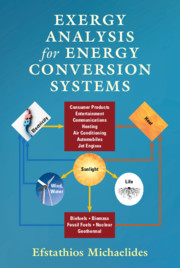Book contents
- Exergy Analysis for Energy Conversion Systems
- Exergy Analysis for Energy Conversion Systems
- Copyright page
- Dedication
- Contents
- About the Author
- Preface
- Symbols
- Abbreviations
- 1 Introduction
- 2 Exergy
- 3 Energy Conversion Systems and Processes
- 4 Exergy Consumption and Conservation
- 5 Exergy in Biological Systems
- 6 Ecosystems, the Environment, and Sustainability
- 7 Optimization and Exergoeconomics
- Index
- References
4 - Exergy Consumption and Conservation
Published online by Cambridge University Press: 19 March 2021
- Exergy Analysis for Energy Conversion Systems
- Exergy Analysis for Energy Conversion Systems
- Copyright page
- Dedication
- Contents
- About the Author
- Preface
- Symbols
- Abbreviations
- 1 Introduction
- 2 Exergy
- 3 Energy Conversion Systems and Processes
- 4 Exergy Consumption and Conservation
- 5 Exergy in Biological Systems
- 6 Ecosystems, the Environment, and Sustainability
- 7 Optimization and Exergoeconomics
- Index
- References
Summary
Our society does not need energy per se. We use the various forms of energy to accomplish desired actions – commuting to work, keeping the interior of homes at comfortable temperatures, producing industrial goods, etc. The so-called “minimum energy” requirement for processes is actually a thermodynamic maximum, defined by exergy. The application of the exergy methodology determines the benchmark for the minimum energy resources that arerequired to perform the desired actions and tasks. The minimum energy benchmark is determined for several processes including: natural gas transportation, refrigeration, liquefaction, drying, water desalination, and petroleum refining. The energy requirements for the lighting, heating and air-conditioning of buildings are also calculated as well as the minimum energy for the transportation of goods and the commuting of persons in conventional and electric vehicles. Given their importance for the transition to renewable energy forms, the exergy method is applied to energy storage systems. Several examples in this chapter offer assistance and resources for the application of the exergy methodology to energy-consuming systems and processes.
Keywords
- Type
- Chapter
- Information
- Exergy Analysis for Energy Conversion Systems , pp. 147 - 200Publisher: Cambridge University PressPrint publication year: 2021



